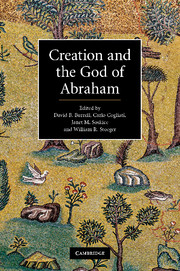Book contents
- Frontmatter
- Contents
- Contributors
- Preface
- Introduction
- 1 Creation ex nihilo: early history
- 2 Creatio ex nihilo: its Jewish and Christian foundations
- 3 The act of creation with its theological consequences
- 4 Scotistic metaphysics and creation ex nihilo
- 5 Creation and the context of theology and science in Maimonides and Crescas
- 6 Creation: Avicenna's metaphysical account
- 7 Four conceptions of creatio ex nihilo and the compatibility questions
- 8 Will, necessity and creation as monistic theophany in the Islamic philosophical tradition
- 9 Trinity, motion and creation ex nihilo
- 10 The Big Bang, quantum cosmology and creatio ex nihilo
- 11 What is written into creation?
- 12 Creatio ex nihilo and dual causality
- 13 God and creatures acting: the idea of double agency
- 14 Thomas Aquinas on knowing and coming to know: the beatific vision and learning from contingency
- Index
- References
11 - What is written into creation?
Published online by Cambridge University Press: 07 September 2010
- Frontmatter
- Contents
- Contributors
- Preface
- Introduction
- 1 Creation ex nihilo: early history
- 2 Creatio ex nihilo: its Jewish and Christian foundations
- 3 The act of creation with its theological consequences
- 4 Scotistic metaphysics and creation ex nihilo
- 5 Creation and the context of theology and science in Maimonides and Crescas
- 6 Creation: Avicenna's metaphysical account
- 7 Four conceptions of creatio ex nihilo and the compatibility questions
- 8 Will, necessity and creation as monistic theophany in the Islamic philosophical tradition
- 9 Trinity, motion and creation ex nihilo
- 10 The Big Bang, quantum cosmology and creatio ex nihilo
- 11 What is written into creation?
- 12 Creatio ex nihilo and dual causality
- 13 God and creatures acting: the idea of double agency
- 14 Thomas Aquinas on knowing and coming to know: the beatific vision and learning from contingency
- Index
- References
Summary
INTRODUCTION
It is difficult to see what science can usefully say about creatio ex nihilo. Even to describe it as an ‘event’ begs the question of prior nothing as against historical something. The latter is patently open to scientific investigation, but the former and any conceivable connecting factor are matters (so to speak) for metaphysical discussion. Even the fashionable suppositions of a universe emerging via the agency (again so to speak) of a quantum perturbation would seem to fall into the category of metaphysics, given that any proposed ‘mechanism’ apparently possesses no prior explanation, and would not be open to any sort of experimental verification. Those subscribing to naturalistic, if not materialist, world-pictures seem seldom to perceive a problem; broadly they regard the material universe as a brute fact. Creatio ex nihilo might be an embarrassment, but it is only a potential stumbling-block; as already noted, given it is beyond scientific discourse, the scientists have nothing to contribute.
Even so, no scientist can avoid being embedded in a metaphysical framework (even if it is ostensibly nihilistic or solipsistic), and it is not surprising that the apparent peculiarities of our universe (famously in terms of the apparent ‘fine-tuning’ of the physical constants) sharpen the desire to find an ‘escape clause’ from the ominous sense of a world designed for our habitation and understanding.
- Type
- Chapter
- Information
- Creation and the God of Abraham , pp. 176 - 191Publisher: Cambridge University PressPrint publication year: 2010
References
- 3
- Cited by



